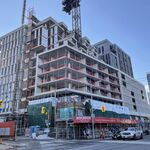SlickFranky
Active Member
EU transfers to less prosperous member states.
Exactly. So unless Alberta wants to finance the DRL we're not in the same situation as Madrid.
EU transfers to less prosperous member states.
Exactly how many people do you think work in downtown Calgary and how much parking do you think they have?
A lot, and proportionately very little. It's a fairly well established fact that their employment is highly centralized.
Colliers said:Downtown Calgary has the most expensive monthly-unreserved spaces in Canada and is second only to New York (US$500 Downtown, US$550 Midtown) in all of North America with a median monthly rate of US$460. Calgary is followed by Toronto ($305), which is the second most expensive Canadian city to rent a space by the month, with Montreal ($280), Edmonton ($275) and Vancouver ($224) closing the top five destinations.
Munich - Olympics (Accelerated for 1972)Well through federal funding Alberta does pay for transit projects. Spain may get EU transfers, but how much of the cost of the metros in Madrid and Barcelona is paid for by the EU? I suspect that our higher per capita wealth makes up the difference.
I was just using Madrid as an example because I was there recently. EU transfers and the Olympics can't explain subway systems in cities like Frankfurt, Munich, Washington DC, etc. Even Philadelphia has more downtown subway lines, as do smaller cities like Prague and poorer cities in Asia. Bottom line is Toronto should have a much larger mass transit system, Olympics or not.
So how do we effectively address the neglect of public transit in this province? How do we change the culture?
Munich - Olympics (Accelerated for 1972)
Frankfurt - Olympics (Accelerated for 1972)
Washington - Capital
Prague - Capital
That leaves Philadelphia, who built their transit off the backs of Reading Railroad and Pennsylvania Railroad (remember Monopoly?). The biggest restriction we've had on our system is that we are operating in mixed-traffic on freight owned corridors (speaking regionally as GO was created around the same time as SEPTA).
I think part of the trouble with the Yonge ridership numbers is that there isn't an alternative N-S subway line, so regardless of where you want to go, if you want/need to go N-S by subway it's on Yonge.
I think that dedicated funding sources are needed to really address the public transit deficit. Reliance on the general tax base won't get us very far, since transit will always lose to higher-priority portfolios such as health care, education, and policing.
Road tolls is one option, and I like Sarah Thomson suggesting to impose tolls on the expressways leading into the downtown core. This may not be a comprehensive solution, but is something to start with, and can be implemented by the City Council alone.
Another possibility is a gas surtax levied on gas purchases within Toronto, Mississauga, York Region, and Ottawa, but exempting less dence parts of Ontario where no viable public transit exists. Obviously, this scheme can be implemented by the provincial government only.
Metropolitan Toronto was incorporated in 1953. Three months later, Metro council approved the Lakeshore Expressway. Construction was approved in 1954. The Gardiner Expressway (a.k.a. Lakeshore Expressway) opened from the Humber River to Jameson Avenue by 1958. Five years from idea to reality.
Toronto first proposal for a streetcar subway under Yonge Street came in 1909. It took the 1946 referendum for a Yonge HRT and Queen LRT subways to be approved by voters. Construction began for the Yonge subway in 1948. Only the Yonge Street HRT subway opened by 1954. The Queen subway (or Downtown Relief Line) is still waiting, even though it was approved by voters in 1946.
It takes longer for any public transit project to become reality. Even though expressways are much more disruptive, and public transit is more beneficial, the results are more on the side of expressways than public transit. Just see how easy it is for the 905 areas to get their expressways, than the 416 and the GTA to get public transit projects.
Well through federal funding Alberta does pay for transit projects. Spain may get EU transfers, but how much of the cost of the metros in Madrid and Barcelona is paid for by the EU? I suspect that our higher per capita wealth makes up the difference.




